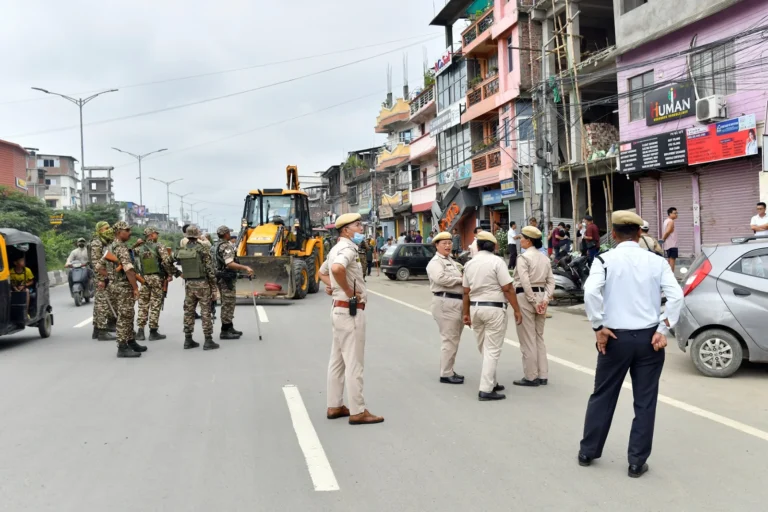Manipur: Security Forces Deploy Tear Gas and Blank Fire to Disperse Mobs Near BJP MLA’s Residence
Summary
In a tense escalation of violence in Manipur, security forces were compelled to use tear gas and blank fire to control a mob near the residence of a BJP MLA in Imphal. This development comes amidst ongoing unrest between tribal and Meitei communities, further straining the state’s law and order situation. The central government’s intervention under Article 355 has sought to manage the spiraling crisis while addressing the communal tensions at the heart of the conflict
Long Form Article
Introduction
Manipur, a state with a rich cultural tapestry, is no stranger to conflict. However, the recent violence gripping the state has taken a troubling turn. Incidents of unrest between tribal and Meitei groups have spiraled into mob violence, property destruction, and attacks on political representatives. Security forces have stepped in, but their interventions—such as the use of tear gas and blank fire—highlight the dire circumstances on the ground.
In this article, we’ll dive deep into the recent clashes, the implications for the state’s future, and the government’s strategies to restore normalcy.
What Led to the Escalation?
Manipur has been witnessing a growing divide between the tribal communities, particularly the Kukis, and the Meitei majority. Underlying these tensions are disputes over land ownership, migration, and identity politics. The central spark has been claims regarding illegal settlements and cultural differences, which have led to protests and violent clashes across the state.
Recent incidents, such as mobs targeting the homes of BJP representatives, indicate the intensity of the public’s frustration. The root causes remain intertwined with historical grievances, political decisions, and socio-economic disparities
Security Forces and Their Response
On the evening of the attack, a mob attempted to breach the security perimeter around a BJP MLA’s residence in Imphal. The security personnel were forced to resort to non-lethal methods, such as blank firing and tear gas shells, to disperse the crowd. While these measures managed to quell the immediate threat, they underscore the fragile peace in the region.
Security measures, including roadblocks and increased patrolling, have been implemented across sensitive areas. Yet, the unrest remains a challenge for local and central authorities alike
The Role of Article 355
The Indian government has invoked Article 355 of the Constitution, empowering the center to take measures to restore peace in Manipur. This provision allows the Union to intervene in the event of internal disturbances threatening the state’s stability. By deploying additional forces and coordinating relief efforts, the central government aims to mitigate the crisis. However, critics argue that long-term solutions require addressing the underlying tensions, not just curbing the immediate violence
.
Impact on Daily Life
For the citizens of Manipur, the ongoing crisis has disrupted normal life. Internet suspensions, curfews, and restricted movement have left people feeling isolated and insecure. Businesses remain shuttered, schools are closed, and essential services are often interrupted. The economic and emotional toll on the population is immeasurable, with many questioning the effectiveness of the government’s approach to restoring order.
What Needs to Be Done?
Addressing the Manipur crisis requires a multi-faceted approach:
- Dialogue Between Communities: Genuine efforts to foster understanding between tribal and Meitei groups are essential to heal decades of mistrust.
- Fair Policy Implementation: Policies regarding land rights, cultural autonomy, and economic development must be equitable and inclusive.
- Community Policing and Local Governance: Strengthening local governance can help de-escalate tensions and provide platforms for grievances to be aired constructively.
- Long-Term Economic Investments: Improved infrastructure and job opportunities can reduce socio-economic disparities, a core driver of the conflict.
Conclusion
Manipur stands at a crossroads. The current violence, marked by the use of force by security personnel, is a stark reminder of the state’s delicate socio-political fabric. While immediate measures like Article 355 can help stabilize the situation, long-lasting peace will require addressing the deeper fault lines dividing its communities. The question remains: can Manipur rise above these challenges and pave the way for unity?
FAQs
- What is Article 355, and how is it being used in Manipur?
Article 355 empowers the central government to intervene in a state to maintain law and order, particularly during internal disturbances. - Why are there tensions between tribal and Meitei groups?
The conflict stems from disputes over land, migration, and cultural differences, with historical grievances fueling current unrest. - How have security forces responded to the violence?
Security forces have used tear gas and blank fire to disperse mobs and prevent property damage, highlighting the severity of the unrest. - What are the long-term implications of this crisis?
Prolonged violence could further divide communities, disrupt the state’s economy, and strain relationships with the central government. - How can peace be restored in Manipur?
Promoting dialogue, implementing fair policies, and addressing socio-economic disparities are critical steps toward lasting peace.
Tags
Manipur crisis, Article 355, tribal-Meitei conflict, BJP MLA attack, security forces, tear gas, blank fire, Manipur unrest, cultural tensions, law and order





